BSBWOR501: Manage Personal Work Priorities and Development
VerifiedAdded on 2022/08/16
|34
|4096
|25
Homework Assignment
AI Summary
This document provides a comprehensive solution for the BSBWOR501 assessment, focusing on managing personal work priorities and professional development. It includes detailed answers to short-answer questions exploring attributes of a positive role model, core values, mission statements, future visions, and SMART goals. The assessment also covers measuring progress through KPIs and MOS, aligning personal goals with organizational plans, and identifying potential barriers to success. Furthermore, it delves into time management techniques, efficient use of technology, stress management strategies, networking participation, and interpersonal skills. The document also provides multiple-choice answers based on a case study of a store manager. Finally, it includes a food and beverage job description and organizational charts. This assignment is a valuable resource for students seeking to understand and excel in the BSBWOR501 unit.

BSBWOR501 Manage personal work priorities and
professional development
Assessment
professional development
Assessment
Paraphrase This Document
Need a fresh take? Get an instant paraphrase of this document with our AI Paraphraser
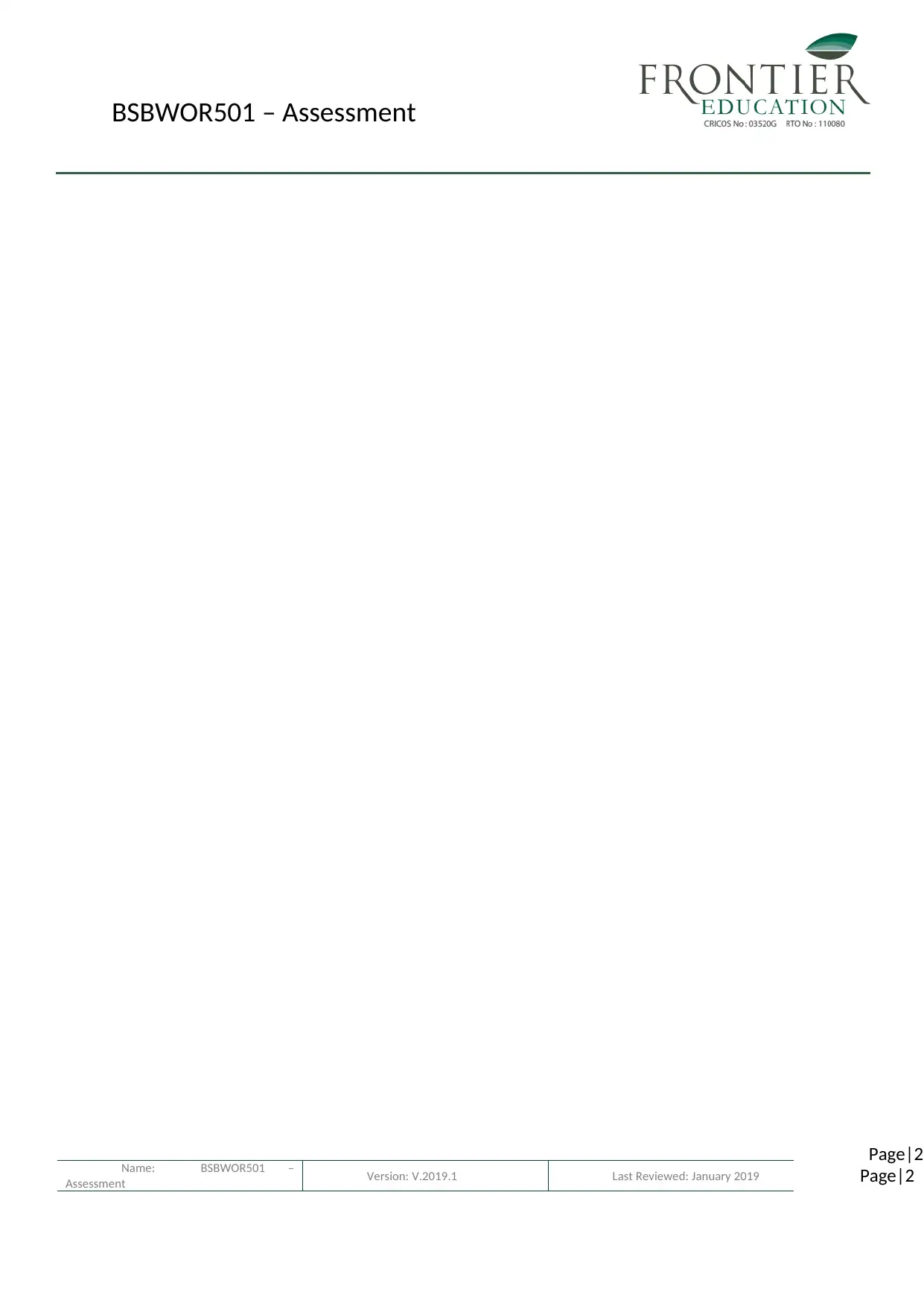
BSBWOR501 – Assessment
Page|2
Name: BSBWOR501 –
Assessment Version: V.2019.1 Last Reviewed: January 2019 Page|2
Page|2
Name: BSBWOR501 –
Assessment Version: V.2019.1 Last Reviewed: January 2019 Page|2
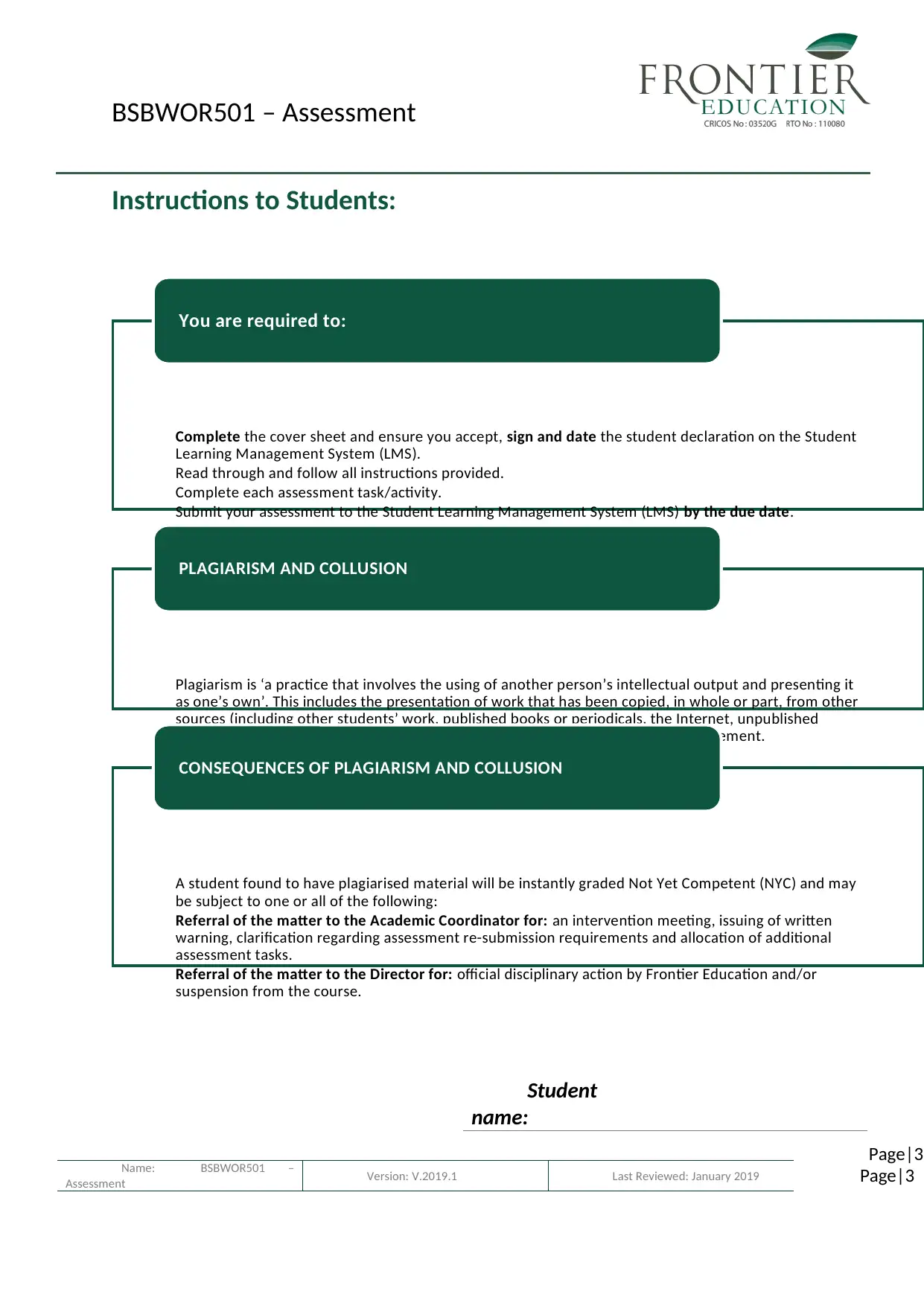
BSBWOR501 – Assessment
Instructions to Students:
Student
name:
Complete the cover sheet and ensure you accept, sign and date the student declaration on the Student
Learning Management System (LMS).
Read through and follow all instructions provided.
Complete each assessment task/activity.
Submit your assessment to the Student Learning Management System (LMS) by the due date.
Ensure your submission identifies your name, unit code and title.
You are required to:
Plagiarism is ‘a practice that involves the using of another person’s intellectual output and presenting it
as one’s own’. This includes the presentation of work that has been copied, in whole or part, from other
sources (including other students’ work, published books or periodicals, the Internet, unpublished
works or unauthorised collaboration with other persons), without due acknowledgement.
PLAGIARISM AND COLLUSION
A student found to have plagiarised material will be instantly graded Not Yet Competent (NYC) and may
be subject to one or all of the following:
Referral of the matter to the Academic Coordinator for: an intervention meeting, issuing of written
warning, clarification regarding assessment re-submission requirements and allocation of additional
assessment tasks.
Referral of the matter to the Director for: official disciplinary action by Frontier Education and/or
suspension from the course.
CONSEQUENCES OF PLAGIARISM AND COLLUSION
Page|3
Name: BSBWOR501 –
Assessment Version: V.2019.1 Last Reviewed: January 2019 Page|3
Instructions to Students:
Student
name:
Complete the cover sheet and ensure you accept, sign and date the student declaration on the Student
Learning Management System (LMS).
Read through and follow all instructions provided.
Complete each assessment task/activity.
Submit your assessment to the Student Learning Management System (LMS) by the due date.
Ensure your submission identifies your name, unit code and title.
You are required to:
Plagiarism is ‘a practice that involves the using of another person’s intellectual output and presenting it
as one’s own’. This includes the presentation of work that has been copied, in whole or part, from other
sources (including other students’ work, published books or periodicals, the Internet, unpublished
works or unauthorised collaboration with other persons), without due acknowledgement.
PLAGIARISM AND COLLUSION
A student found to have plagiarised material will be instantly graded Not Yet Competent (NYC) and may
be subject to one or all of the following:
Referral of the matter to the Academic Coordinator for: an intervention meeting, issuing of written
warning, clarification regarding assessment re-submission requirements and allocation of additional
assessment tasks.
Referral of the matter to the Director for: official disciplinary action by Frontier Education and/or
suspension from the course.
CONSEQUENCES OF PLAGIARISM AND COLLUSION
Page|3
Name: BSBWOR501 –
Assessment Version: V.2019.1 Last Reviewed: January 2019 Page|3
⊘ This is a preview!⊘
Do you want full access?
Subscribe today to unlock all pages.

Trusted by 1+ million students worldwide
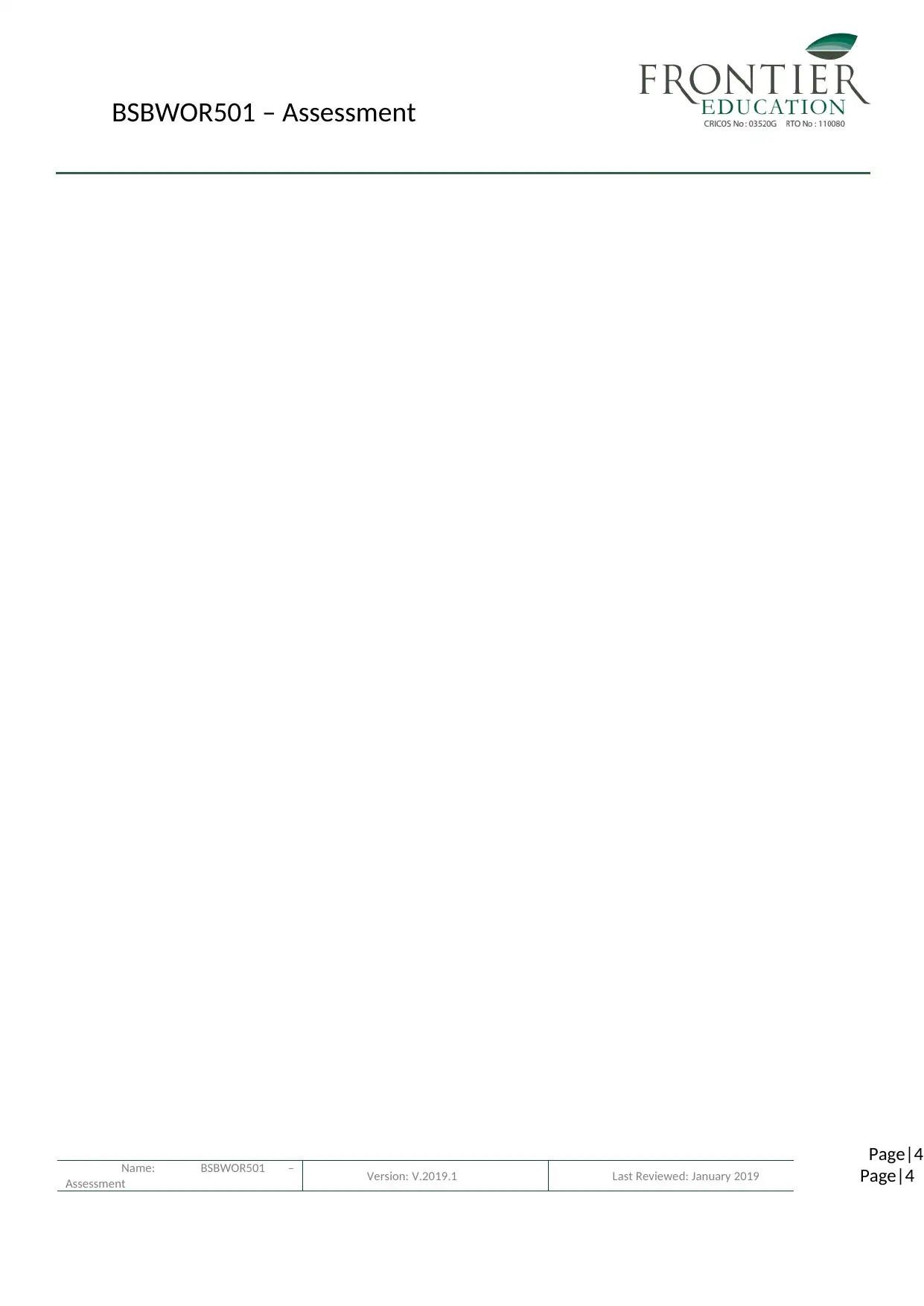
BSBWOR501 – Assessment
Page|4
Name: BSBWOR501 –
Assessment Version: V.2019.1 Last Reviewed: January 2019 Page|4
Page|4
Name: BSBWOR501 –
Assessment Version: V.2019.1 Last Reviewed: January 2019 Page|4
Paraphrase This Document
Need a fresh take? Get an instant paraphrase of this document with our AI Paraphraser
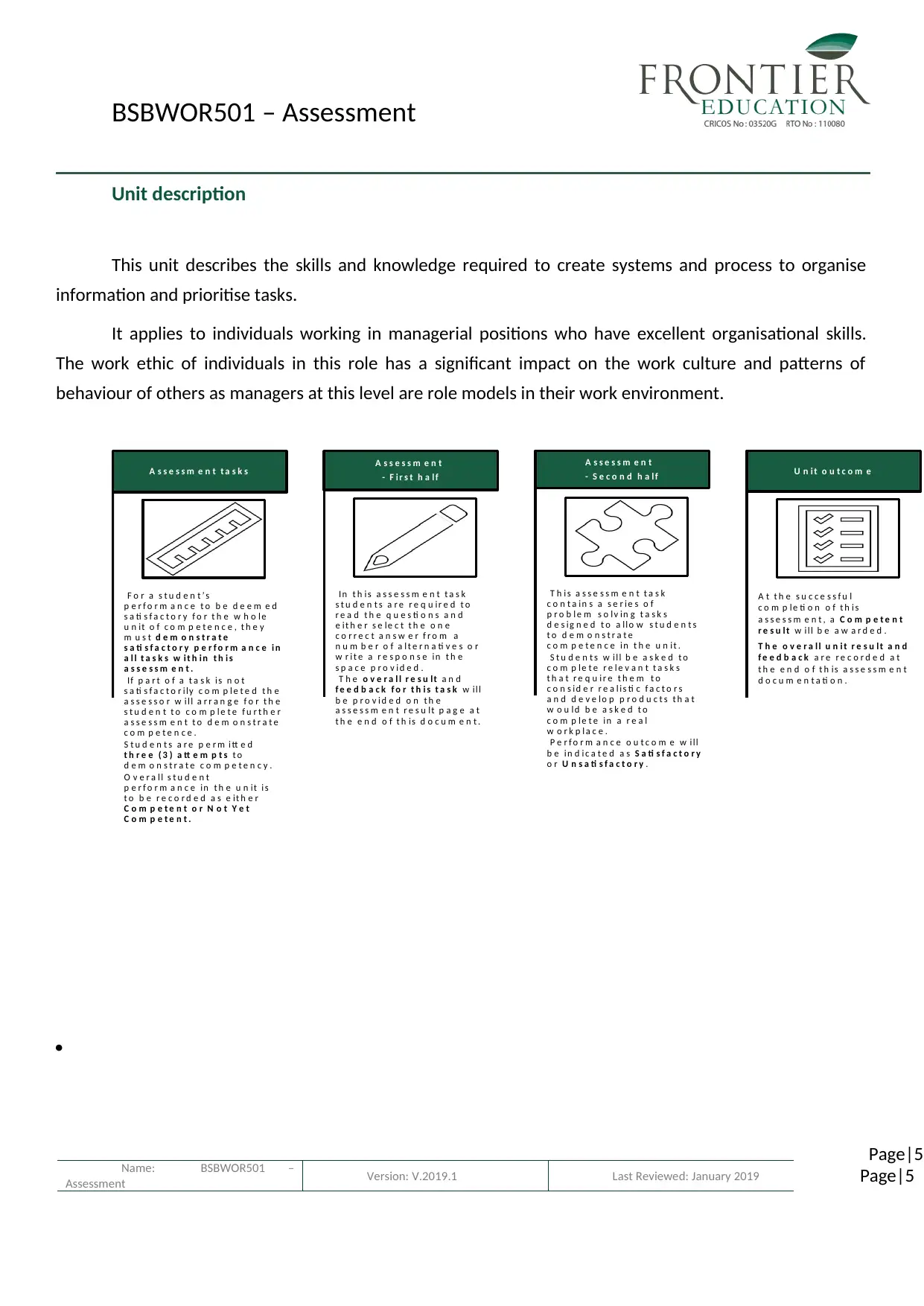
BSBWOR501 – Assessment
Unit description
This unit describes the skills and knowledge required to create systems and process to organise
information and prioritise tasks.
It applies to individuals working in managerial positions who have excellent organisational skills.
The work ethic of individuals in this role has a significant impact on the work culture and patterns of
behaviour of others as managers at this level are role models in their work environment.
F o r a s t u d e n t ’ s
p e r f o r m a n c e t o b e d e e m e d
s a ti s f a c t o r y f o r t h e w h o l e
u n it o f c o m p e t e n c e , t h e y
m u s t d e m o n s t r a t e
s a ti s f a c t o r y p e r f o r m a n c e i n
a l l t a s k s w i t h i n t h i s
a s s e s s m e n t .
I f p a r t o f a t a s k i s n o t
s a ti s f a c t o r i ly c o m p l e t e d t h e
a s s e s s o r w i l l a r r a n g e f o r t h e
s t u d e n t t o c o m p l e t e f u r t h e r
a s s e s s m e n t t o d e m o n s t r a t e
c o m p e t e n c e .
S t u d e n t s a r e p e r m i tt e d
t h r e e ( 3 ) a tt e m p t s t o
d e m o n s t r a t e c o m p e t e n c y .
O v e r a l l s t u d e n t
p e r f o r m a n c e in t h e u n it i s
t o b e r e c o r d e d a s e it h e r
C o m p e t e n t o r N o t Y e t
C o m p e t e n t .
A s s e s s m e n t t a s k s
I n t h i s a s s e s s m e n t t a s k
s t u d e n t s a r e r e q u i r e d t o
r e a d t h e q u e s ti o n s a n d
e i t h e r s e le c t t h e o n e
c o r r e c t a n s w e r f r o m a
n u m b e r o f a l t e r n a ti v e s o r
w r i t e a r e s p o n s e i n t h e
s p a c e p r o v i d e d .
T h e o v e r a l l r e s u l t a n d
f e e d b a c k f o r t h i s t a s k w il l
b e p r o v i d e d o n t h e
a s s e s s m e n t r e s u l t p a g e a t
t h e e n d o f t h is d o c u m e n t .
A s s e s s m e n t
- F i r s t h a l f
T h i s a s s e s s m e n t t a s k
c o n t a i n s a s e r i e s o f
p r o b l e m s o l v i n g t a s k s
d e s i g n e d t o a ll o w s t u d e n t s
t o d e m o n s t r a t e
c o m p e t e n c e i n t h e u n i t .
S t u d e n t s w i l l b e a s k e d t o
c o m p l e t e r e l e v a n t t a s k s
t h a t r e q u i r e t h e m t o
c o n s i d e r r e a l i s ti c f a c t o r s
a n d d e v e lo p p r o d u c t s t h a t
w o u l d b e a s k e d t o
c o m p l e t e in a r e a l
w o r k p l a c e .
P e r f o r m a n c e o u t c o m e w i ll
b e i n d i c a t e d a s S a ti s f a c t o r y
o r U n s a ti s f a c t o r y .
A s s e s s m e n t
- S e c o n d h a l f
A t t h e s u c c e s s f u l
c o m p l e ti o n o f t h i s
a s s e s s m e n t , a C o m p e t e n t
r e s u l t w i l l b e a w a r d e d .
T h e o v e r a l l u n i t r e s u l t a n d
f e e d b a c k a r e r e c o r d e d a t
t h e e n d o f t h i s a s s e s s m e n t
d o c u m e n t a ti o n .
U n i t o u t c o m e
Page|5
Name: BSBWOR501 –
Assessment Version: V.2019.1 Last Reviewed: January 2019 Page|5
Unit description
This unit describes the skills and knowledge required to create systems and process to organise
information and prioritise tasks.
It applies to individuals working in managerial positions who have excellent organisational skills.
The work ethic of individuals in this role has a significant impact on the work culture and patterns of
behaviour of others as managers at this level are role models in their work environment.
F o r a s t u d e n t ’ s
p e r f o r m a n c e t o b e d e e m e d
s a ti s f a c t o r y f o r t h e w h o l e
u n it o f c o m p e t e n c e , t h e y
m u s t d e m o n s t r a t e
s a ti s f a c t o r y p e r f o r m a n c e i n
a l l t a s k s w i t h i n t h i s
a s s e s s m e n t .
I f p a r t o f a t a s k i s n o t
s a ti s f a c t o r i ly c o m p l e t e d t h e
a s s e s s o r w i l l a r r a n g e f o r t h e
s t u d e n t t o c o m p l e t e f u r t h e r
a s s e s s m e n t t o d e m o n s t r a t e
c o m p e t e n c e .
S t u d e n t s a r e p e r m i tt e d
t h r e e ( 3 ) a tt e m p t s t o
d e m o n s t r a t e c o m p e t e n c y .
O v e r a l l s t u d e n t
p e r f o r m a n c e in t h e u n it i s
t o b e r e c o r d e d a s e it h e r
C o m p e t e n t o r N o t Y e t
C o m p e t e n t .
A s s e s s m e n t t a s k s
I n t h i s a s s e s s m e n t t a s k
s t u d e n t s a r e r e q u i r e d t o
r e a d t h e q u e s ti o n s a n d
e i t h e r s e le c t t h e o n e
c o r r e c t a n s w e r f r o m a
n u m b e r o f a l t e r n a ti v e s o r
w r i t e a r e s p o n s e i n t h e
s p a c e p r o v i d e d .
T h e o v e r a l l r e s u l t a n d
f e e d b a c k f o r t h i s t a s k w il l
b e p r o v i d e d o n t h e
a s s e s s m e n t r e s u l t p a g e a t
t h e e n d o f t h is d o c u m e n t .
A s s e s s m e n t
- F i r s t h a l f
T h i s a s s e s s m e n t t a s k
c o n t a i n s a s e r i e s o f
p r o b l e m s o l v i n g t a s k s
d e s i g n e d t o a ll o w s t u d e n t s
t o d e m o n s t r a t e
c o m p e t e n c e i n t h e u n i t .
S t u d e n t s w i l l b e a s k e d t o
c o m p l e t e r e l e v a n t t a s k s
t h a t r e q u i r e t h e m t o
c o n s i d e r r e a l i s ti c f a c t o r s
a n d d e v e lo p p r o d u c t s t h a t
w o u l d b e a s k e d t o
c o m p l e t e in a r e a l
w o r k p l a c e .
P e r f o r m a n c e o u t c o m e w i ll
b e i n d i c a t e d a s S a ti s f a c t o r y
o r U n s a ti s f a c t o r y .
A s s e s s m e n t
- S e c o n d h a l f
A t t h e s u c c e s s f u l
c o m p l e ti o n o f t h i s
a s s e s s m e n t , a C o m p e t e n t
r e s u l t w i l l b e a w a r d e d .
T h e o v e r a l l u n i t r e s u l t a n d
f e e d b a c k a r e r e c o r d e d a t
t h e e n d o f t h i s a s s e s s m e n t
d o c u m e n t a ti o n .
U n i t o u t c o m e
Page|5
Name: BSBWOR501 –
Assessment Version: V.2019.1 Last Reviewed: January 2019 Page|5

BSBWOR501 – Assessment
TASK A – SHORT ANSWER
INSTRUCTIONS:
You are to answer all questions.
Read each question carefully.
Ensure you have provided all required information.
Q1: Describe the attributes you possess and behaviours you demonstrate which make you a positive
role model in the workplace.
These are the traits an individual must possess and demonstrate, which makes them an optimistic
role model in their place of work.
Uncompromising integrity: An individual must be committed to the benefits of the
organization. Employees must be patient in any situation.
Staying level head: Chaotic situations must not affect the performance of employees.
Goal orientation and time management: A good employee must be able to achieve his
goals in the allocated time.
Enthusiastic and inspiring: Good employee possesses positive energy which makes
people loyal to them.
Satisfactory ☐ Unsatisfactory ☐
Q2: List your five (5) core values.
1. Committed and dedicated hard worker
2. Helping others grow
3. Manage time effectively
4. Give constructive feedback
5. Staying composed under extreme work pressure
Satisfactory ☐ Unsatisfactory ☐
Page|6
Name: BSBWOR501 –
Assessment Version: V.2019.1 Last Reviewed: January 2019 Page|6
TASK A – SHORT ANSWER
INSTRUCTIONS:
You are to answer all questions.
Read each question carefully.
Ensure you have provided all required information.
Q1: Describe the attributes you possess and behaviours you demonstrate which make you a positive
role model in the workplace.
These are the traits an individual must possess and demonstrate, which makes them an optimistic
role model in their place of work.
Uncompromising integrity: An individual must be committed to the benefits of the
organization. Employees must be patient in any situation.
Staying level head: Chaotic situations must not affect the performance of employees.
Goal orientation and time management: A good employee must be able to achieve his
goals in the allocated time.
Enthusiastic and inspiring: Good employee possesses positive energy which makes
people loyal to them.
Satisfactory ☐ Unsatisfactory ☐
Q2: List your five (5) core values.
1. Committed and dedicated hard worker
2. Helping others grow
3. Manage time effectively
4. Give constructive feedback
5. Staying composed under extreme work pressure
Satisfactory ☐ Unsatisfactory ☐
Page|6
Name: BSBWOR501 –
Assessment Version: V.2019.1 Last Reviewed: January 2019 Page|6
⊘ This is a preview!⊘
Do you want full access?
Subscribe today to unlock all pages.

Trusted by 1+ million students worldwide

BSBWOR501 – Assessment
Q3: Write a one-sentence mission statement for yourself.
My main motive is to be in a position whether I am self- employed or working for someone else,
where I can earn huge amount of money with working for less hours. My mission is to afford a life where
I have a wonderful home, a beautiful environment, and a bright future for my family. Thus we can enjoy
our life and live peacefully.
Satisfactory ☐ Unsatisfactory ☐
Q4: Reflect on your vision for the future. Ideally, where do you see yourself in five or ten years’ time
personally and professionally? Briefly describe your future vision which aligns with your core
values and mission.
In five years, I am planning to stay in Tasmania and probably find some friends who would like to
start a small business with my family and me. But the details still need to have further discussed. I have
worked as a bank manager for seven years. I can use my financial experience to help to establish a small
business. And I want to have my family come to Tasmania and live together and then to teach my parents
English to make them get along with local people in a foreign country which is entirely different from
their past.
Satisfactory ☐ Unsatisfactory ☐
Q5: List three (3) personal or professional SMARTT goals you’re currently working
towards. Ensure at least one of these goals fits within an organisational structure (even if it’s a club,
team, community group, etc., rather than a workplace).
1. Reducing the number of customer complaint by 2% in the food department
Page|7
Name: BSBWOR501 –
Assessment Version: V.2019.1 Last Reviewed: January 2019 Page|7
Q3: Write a one-sentence mission statement for yourself.
My main motive is to be in a position whether I am self- employed or working for someone else,
where I can earn huge amount of money with working for less hours. My mission is to afford a life where
I have a wonderful home, a beautiful environment, and a bright future for my family. Thus we can enjoy
our life and live peacefully.
Satisfactory ☐ Unsatisfactory ☐
Q4: Reflect on your vision for the future. Ideally, where do you see yourself in five or ten years’ time
personally and professionally? Briefly describe your future vision which aligns with your core
values and mission.
In five years, I am planning to stay in Tasmania and probably find some friends who would like to
start a small business with my family and me. But the details still need to have further discussed. I have
worked as a bank manager for seven years. I can use my financial experience to help to establish a small
business. And I want to have my family come to Tasmania and live together and then to teach my parents
English to make them get along with local people in a foreign country which is entirely different from
their past.
Satisfactory ☐ Unsatisfactory ☐
Q5: List three (3) personal or professional SMARTT goals you’re currently working
towards. Ensure at least one of these goals fits within an organisational structure (even if it’s a club,
team, community group, etc., rather than a workplace).
1. Reducing the number of customer complaint by 2% in the food department
Page|7
Name: BSBWOR501 –
Assessment Version: V.2019.1 Last Reviewed: January 2019 Page|7
Paraphrase This Document
Need a fresh take? Get an instant paraphrase of this document with our AI Paraphraser
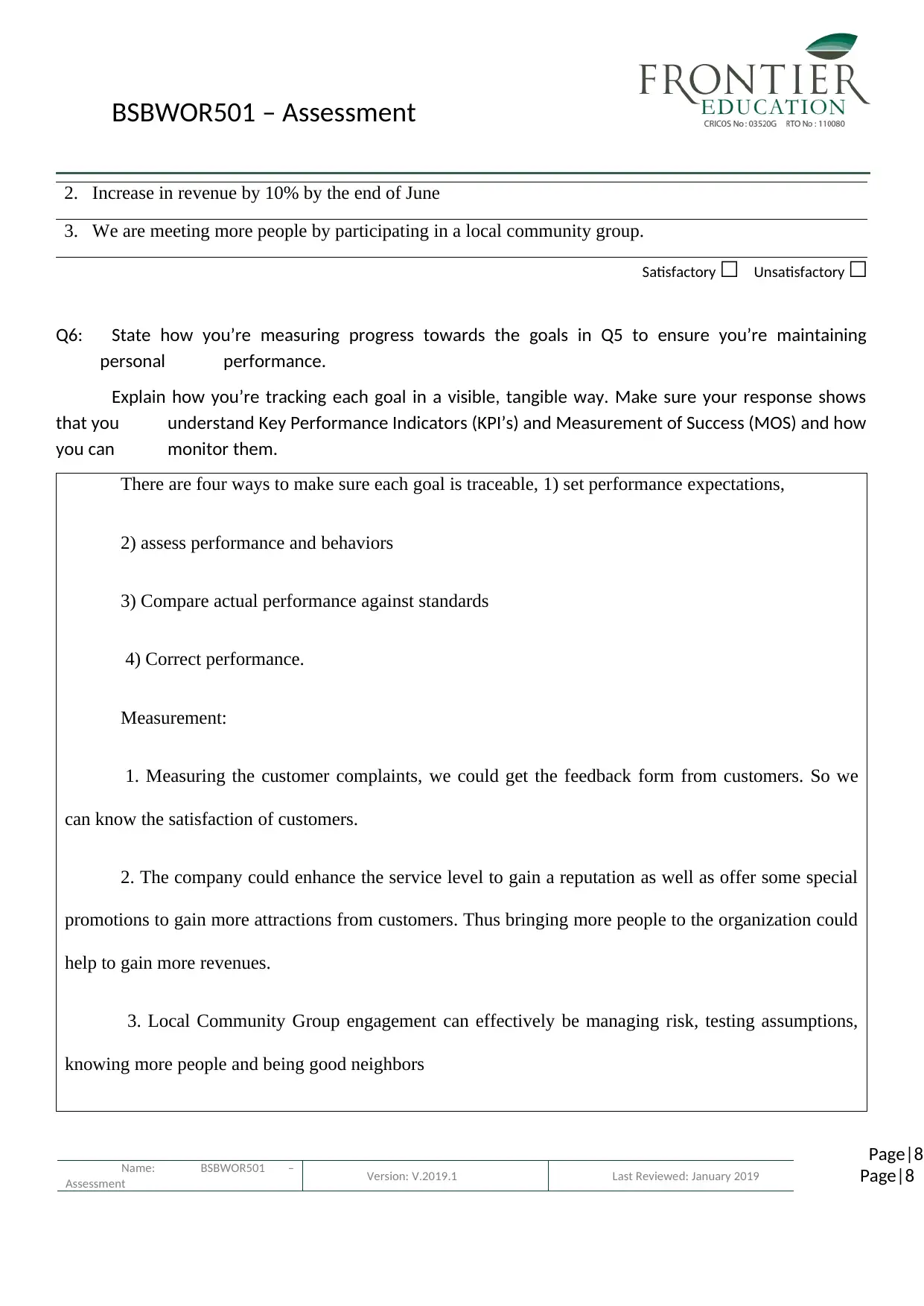
BSBWOR501 – Assessment
2. Increase in revenue by 10% by the end of June
3. We are meeting more people by participating in a local community group.
Satisfactory ☐ Unsatisfactory ☐
Q6: State how you’re measuring progress towards the goals in Q5 to ensure you’re maintaining
personal performance.
Explain how you’re tracking each goal in a visible, tangible way. Make sure your response shows
that you understand Key Performance Indicators (KPI’s) and Measurement of Success (MOS) and how
you can monitor them.
There are four ways to make sure each goal is traceable, 1) set performance expectations,
2) assess performance and behaviors
3) Compare actual performance against standards
4) Correct performance.
Measurement:
1. Measuring the customer complaints, we could get the feedback form from customers. So we
can know the satisfaction of customers.
2. The company could enhance the service level to gain a reputation as well as offer some special
promotions to gain more attractions from customers. Thus bringing more people to the organization could
help to gain more revenues.
3. Local Community Group engagement can effectively be managing risk, testing assumptions,
knowing more people and being good neighbors
Page|8
Name: BSBWOR501 –
Assessment Version: V.2019.1 Last Reviewed: January 2019 Page|8
2. Increase in revenue by 10% by the end of June
3. We are meeting more people by participating in a local community group.
Satisfactory ☐ Unsatisfactory ☐
Q6: State how you’re measuring progress towards the goals in Q5 to ensure you’re maintaining
personal performance.
Explain how you’re tracking each goal in a visible, tangible way. Make sure your response shows
that you understand Key Performance Indicators (KPI’s) and Measurement of Success (MOS) and how
you can monitor them.
There are four ways to make sure each goal is traceable, 1) set performance expectations,
2) assess performance and behaviors
3) Compare actual performance against standards
4) Correct performance.
Measurement:
1. Measuring the customer complaints, we could get the feedback form from customers. So we
can know the satisfaction of customers.
2. The company could enhance the service level to gain a reputation as well as offer some special
promotions to gain more attractions from customers. Thus bringing more people to the organization could
help to gain more revenues.
3. Local Community Group engagement can effectively be managing risk, testing assumptions,
knowing more people and being good neighbors
Page|8
Name: BSBWOR501 –
Assessment Version: V.2019.1 Last Reviewed: January 2019 Page|8
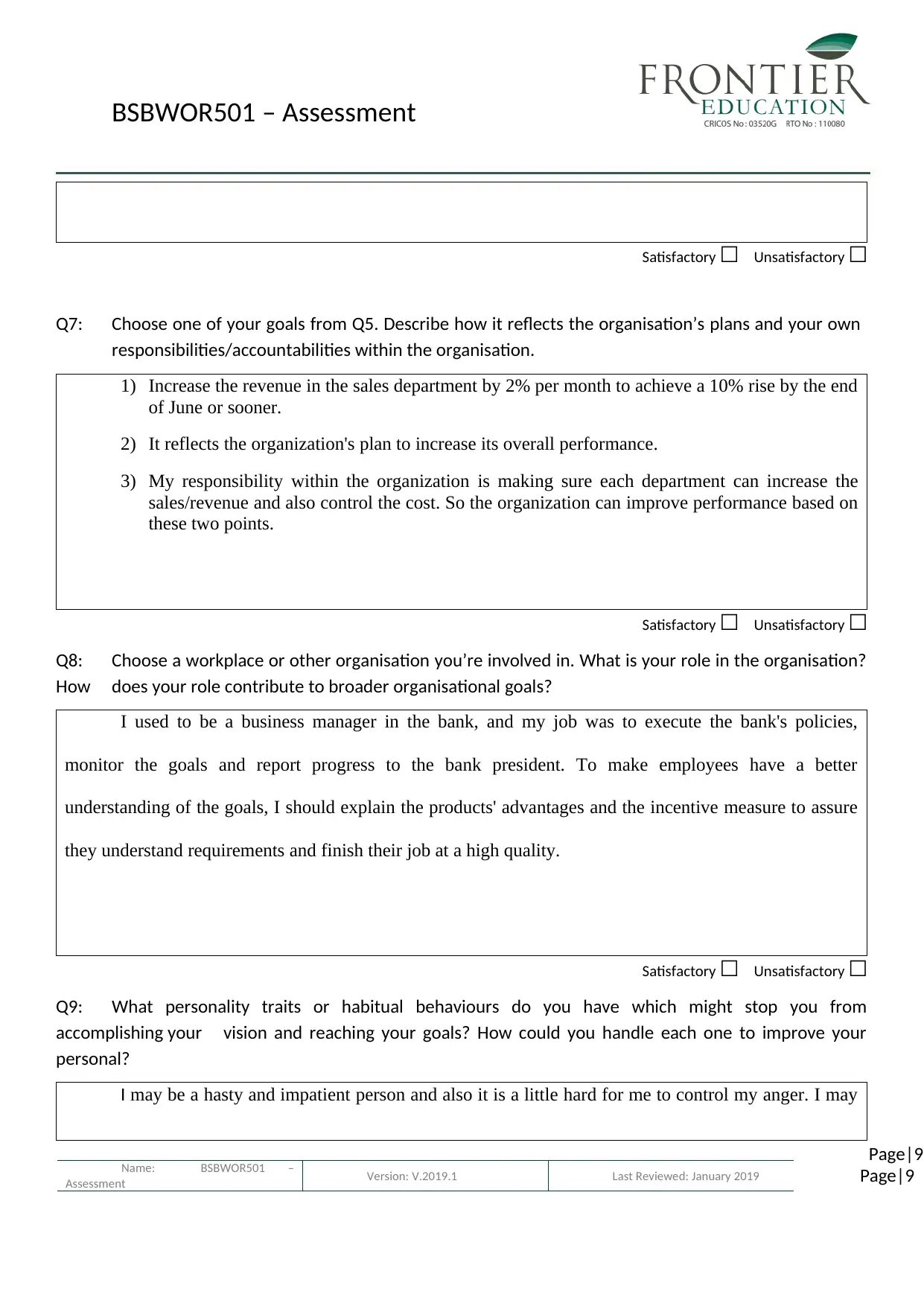
BSBWOR501 – Assessment
Satisfactory ☐ Unsatisfactory ☐
Q7: Choose one of your goals from Q5. Describe how it reflects the organisation’s plans and your own
responsibilities/accountabilities within the organisation.
1) Increase the revenue in the sales department by 2% per month to achieve a 10% rise by the end
of June or sooner.
2) It reflects the organization's plan to increase its overall performance.
3) My responsibility within the organization is making sure each department can increase the
sales/revenue and also control the cost. So the organization can improve performance based on
these two points.
Satisfactory ☐ Unsatisfactory ☐
Q8: Choose a workplace or other organisation you’re involved in. What is your role in the organisation?
How does your role contribute to broader organisational goals?
I used to be a business manager in the bank, and my job was to execute the bank's policies,
monitor the goals and report progress to the bank president. To make employees have a better
understanding of the goals, I should explain the products' advantages and the incentive measure to assure
they understand requirements and finish their job at a high quality.
Satisfactory ☐ Unsatisfactory ☐
Q9: What personality traits or habitual behaviours do you have which might stop you from
accomplishing your vision and reaching your goals? How could you handle each one to improve your
personal?
I may be a hasty and impatient person and also it is a little hard for me to control my anger. I may
Page|9
Name: BSBWOR501 –
Assessment Version: V.2019.1 Last Reviewed: January 2019 Page|9
Satisfactory ☐ Unsatisfactory ☐
Q7: Choose one of your goals from Q5. Describe how it reflects the organisation’s plans and your own
responsibilities/accountabilities within the organisation.
1) Increase the revenue in the sales department by 2% per month to achieve a 10% rise by the end
of June or sooner.
2) It reflects the organization's plan to increase its overall performance.
3) My responsibility within the organization is making sure each department can increase the
sales/revenue and also control the cost. So the organization can improve performance based on
these two points.
Satisfactory ☐ Unsatisfactory ☐
Q8: Choose a workplace or other organisation you’re involved in. What is your role in the organisation?
How does your role contribute to broader organisational goals?
I used to be a business manager in the bank, and my job was to execute the bank's policies,
monitor the goals and report progress to the bank president. To make employees have a better
understanding of the goals, I should explain the products' advantages and the incentive measure to assure
they understand requirements and finish their job at a high quality.
Satisfactory ☐ Unsatisfactory ☐
Q9: What personality traits or habitual behaviours do you have which might stop you from
accomplishing your vision and reaching your goals? How could you handle each one to improve your
personal?
I may be a hasty and impatient person and also it is a little hard for me to control my anger. I may
Page|9
Name: BSBWOR501 –
Assessment Version: V.2019.1 Last Reviewed: January 2019 Page|9
⊘ This is a preview!⊘
Do you want full access?
Subscribe today to unlock all pages.

Trusted by 1+ million students worldwide
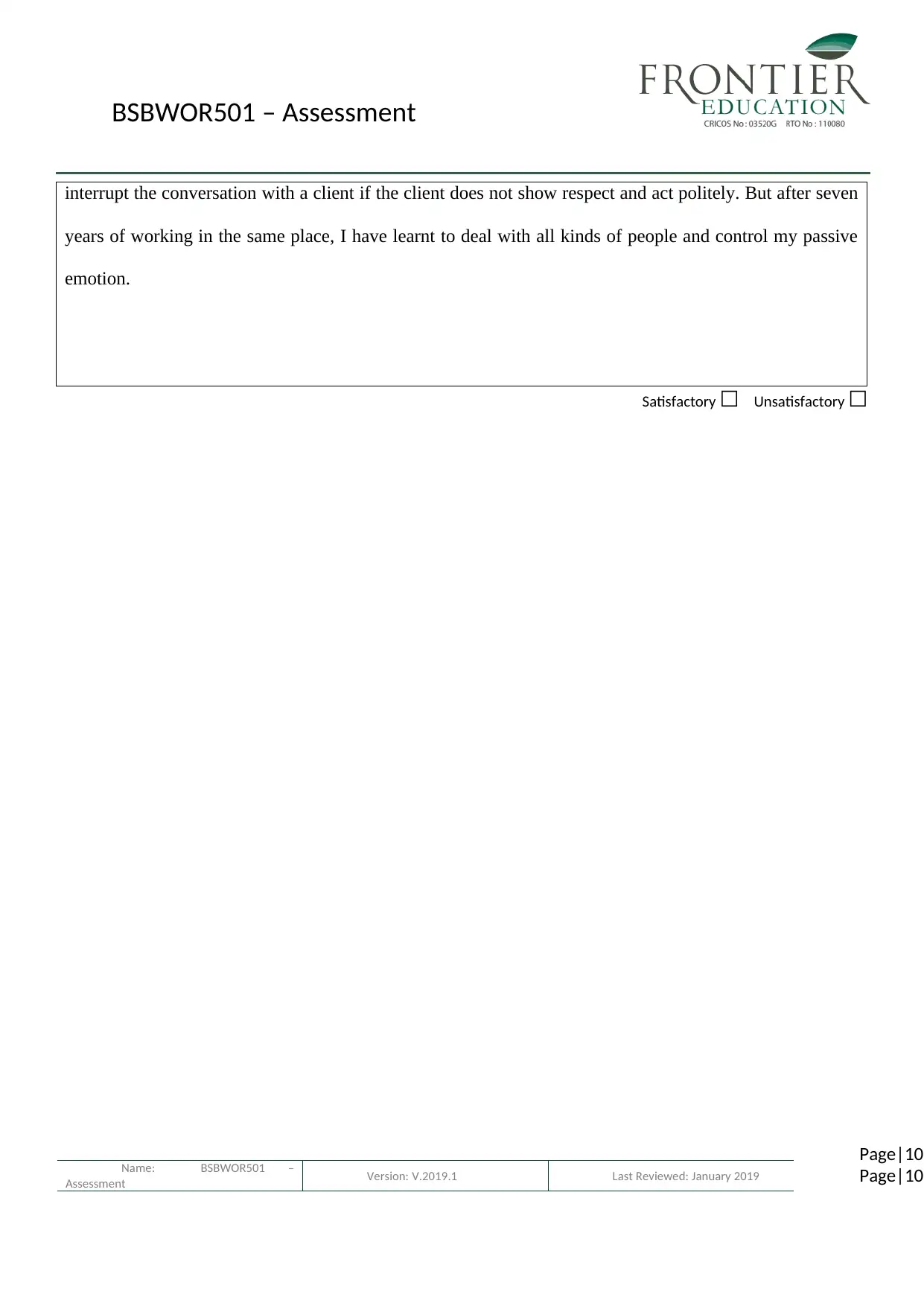
BSBWOR501 – Assessment
interrupt the conversation with a client if the client does not show respect and act politely. But after seven
years of working in the same place, I have learnt to deal with all kinds of people and control my passive
emotion.
Satisfactory ☐ Unsatisfactory ☐
Page|10
Name: BSBWOR501 –
Assessment Version: V.2019.1 Last Reviewed: January 2019 Page|10
interrupt the conversation with a client if the client does not show respect and act politely. But after seven
years of working in the same place, I have learnt to deal with all kinds of people and control my passive
emotion.
Satisfactory ☐ Unsatisfactory ☐
Page|10
Name: BSBWOR501 –
Assessment Version: V.2019.1 Last Reviewed: January 2019 Page|10
Paraphrase This Document
Need a fresh take? Get an instant paraphrase of this document with our AI Paraphraser
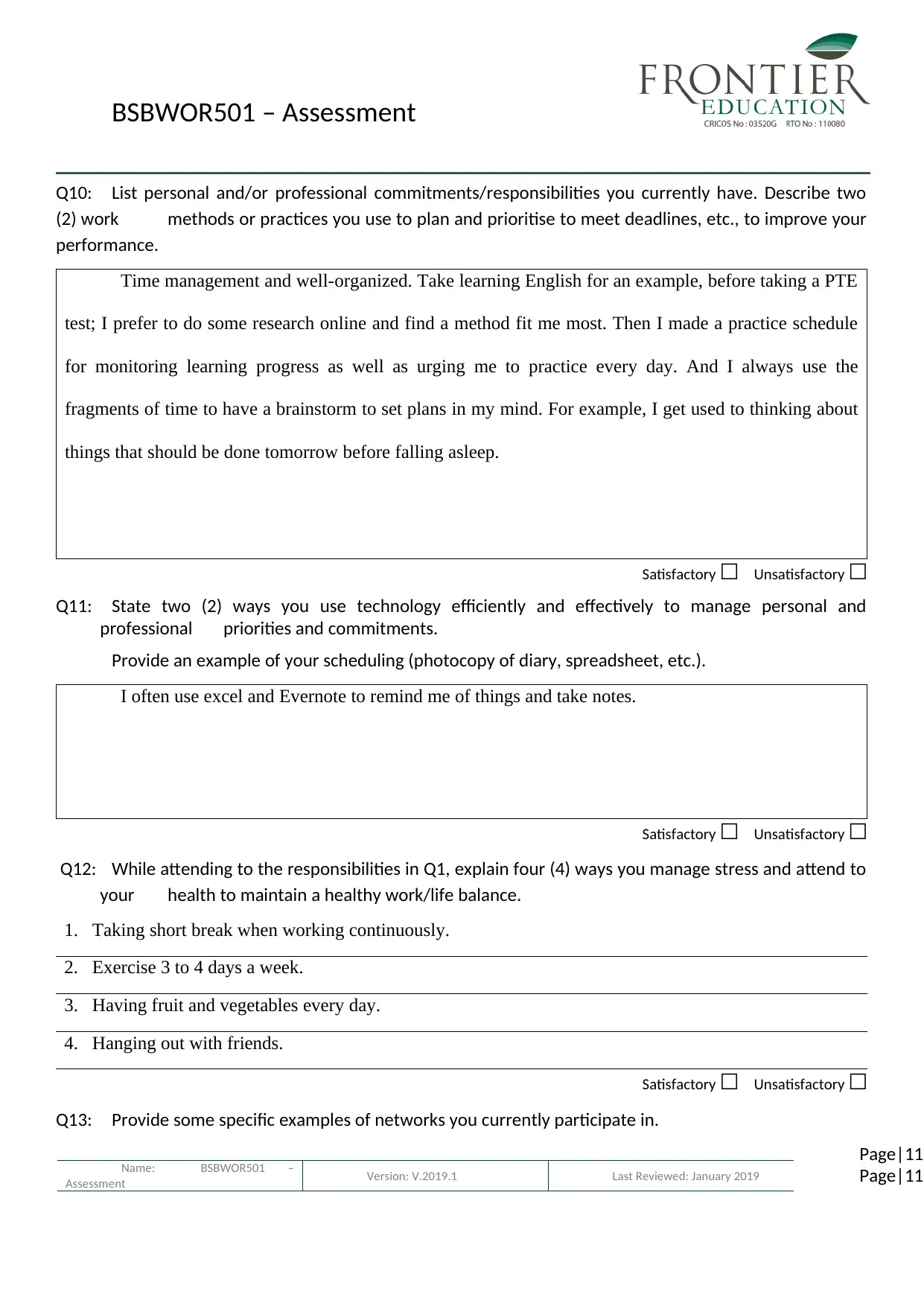
BSBWOR501 – Assessment
Q10: List personal and/or professional commitments/responsibilities you currently have. Describe two
(2) work methods or practices you use to plan and prioritise to meet deadlines, etc., to improve your
performance.
Time management and well-organized. Take learning English for an example, before taking a PTE
test; I prefer to do some research online and find a method fit me most. Then I made a practice schedule
for monitoring learning progress as well as urging me to practice every day. And I always use the
fragments of time to have a brainstorm to set plans in my mind. For example, I get used to thinking about
things that should be done tomorrow before falling asleep.
Satisfactory ☐ Unsatisfactory ☐
Q11: State two (2) ways you use technology efficiently and effectively to manage personal and
professional priorities and commitments.
Provide an example of your scheduling (photocopy of diary, spreadsheet, etc.).
I often use excel and Evernote to remind me of things and take notes.
Satisfactory ☐ Unsatisfactory ☐
Q12: While attending to the responsibilities in Q1, explain four (4) ways you manage stress and attend to
your health to maintain a healthy work/life balance.
1. Taking short break when working continuously.
2. Exercise 3 to 4 days a week.
3. Having fruit and vegetables every day.
4. Hanging out with friends.
Satisfactory ☐ Unsatisfactory ☐
Q13: Provide some specific examples of networks you currently participate in.
Page|11
Name: BSBWOR501 –
Assessment Version: V.2019.1 Last Reviewed: January 2019 Page|11
Q10: List personal and/or professional commitments/responsibilities you currently have. Describe two
(2) work methods or practices you use to plan and prioritise to meet deadlines, etc., to improve your
performance.
Time management and well-organized. Take learning English for an example, before taking a PTE
test; I prefer to do some research online and find a method fit me most. Then I made a practice schedule
for monitoring learning progress as well as urging me to practice every day. And I always use the
fragments of time to have a brainstorm to set plans in my mind. For example, I get used to thinking about
things that should be done tomorrow before falling asleep.
Satisfactory ☐ Unsatisfactory ☐
Q11: State two (2) ways you use technology efficiently and effectively to manage personal and
professional priorities and commitments.
Provide an example of your scheduling (photocopy of diary, spreadsheet, etc.).
I often use excel and Evernote to remind me of things and take notes.
Satisfactory ☐ Unsatisfactory ☐
Q12: While attending to the responsibilities in Q1, explain four (4) ways you manage stress and attend to
your health to maintain a healthy work/life balance.
1. Taking short break when working continuously.
2. Exercise 3 to 4 days a week.
3. Having fruit and vegetables every day.
4. Hanging out with friends.
Satisfactory ☐ Unsatisfactory ☐
Q13: Provide some specific examples of networks you currently participate in.
Page|11
Name: BSBWOR501 –
Assessment Version: V.2019.1 Last Reviewed: January 2019 Page|11

BSBWOR501 – Assessment
1. Online groups such as Wechat, line and Facebook groups. Chatting online to talk with my
friends or others whether they have a job vacancy.
2. Walking into a human resource agency to ask whether they can offer a job.
3. Keeping in touch with Vmac employees to get the latest job information.
4. Participating in the Personalized Programming Learning Environment and University Internship
Program.
sfactory ☐ Unsatisfactory ☐
Q14: Describe how participation in the networks you listed in Q1 has helped you or could help you
develop professionally and be of benefit to you/your business.
Before starting a project, I would like to do some research, such as asking questions related to the
project in online groups and searching for information through some specific websites. Gathering updated
information online helps me keep at the pace of the financial industry and competitors. And asking for the
latest news in an online group can also obtain potential customers.
Satisfactory ☐ Unsatisfactory ☐
Q15: Senior operational personnel establish, conduct and build a variety of relationships as part of
normal daily operations. They also have networks of people they contact for support. List internal and
external customers you currently maintain relationships with.
Page|12
Name: BSBWOR501 –
Assessment Version: V.2019.1 Last Reviewed: January 2019 Page|12
1. Online groups such as Wechat, line and Facebook groups. Chatting online to talk with my
friends or others whether they have a job vacancy.
2. Walking into a human resource agency to ask whether they can offer a job.
3. Keeping in touch with Vmac employees to get the latest job information.
4. Participating in the Personalized Programming Learning Environment and University Internship
Program.
sfactory ☐ Unsatisfactory ☐
Q14: Describe how participation in the networks you listed in Q1 has helped you or could help you
develop professionally and be of benefit to you/your business.
Before starting a project, I would like to do some research, such as asking questions related to the
project in online groups and searching for information through some specific websites. Gathering updated
information online helps me keep at the pace of the financial industry and competitors. And asking for the
latest news in an online group can also obtain potential customers.
Satisfactory ☐ Unsatisfactory ☐
Q15: Senior operational personnel establish, conduct and build a variety of relationships as part of
normal daily operations. They also have networks of people they contact for support. List internal and
external customers you currently maintain relationships with.
Page|12
Name: BSBWOR501 –
Assessment Version: V.2019.1 Last Reviewed: January 2019 Page|12
⊘ This is a preview!⊘
Do you want full access?
Subscribe today to unlock all pages.

Trusted by 1+ million students worldwide
1 out of 34
Related Documents
Your All-in-One AI-Powered Toolkit for Academic Success.
+13062052269
info@desklib.com
Available 24*7 on WhatsApp / Email
![[object Object]](/_next/static/media/star-bottom.7253800d.svg)
Unlock your academic potential
Copyright © 2020–2025 A2Z Services. All Rights Reserved. Developed and managed by ZUCOL.



